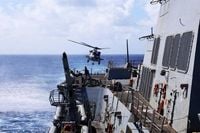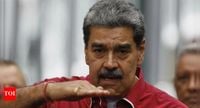Venezuela and the United States have entered a tense new phase in their already fraught relationship, as a massive military buildup unfolds in the Caribbean. On August 19, 2025, President Nicolás Maduro announced the mobilization of 4.5 million militia members across Venezuela, a move he described as a direct response to what he called "extravagant, bizarre, and outlandish threats" from Washington. The announcement came just a day after the United States launched a sweeping military operation in the southern Caribbean, sending warships and thousands of troops toward the Venezuelan coast.
The U.S. operation, authorized by President Donald Trump and coordinated by the U.S. Southern Command (Southcom), involves a formidable array of naval and aerial assets. According to reports from multiple U.S. media outlets, three Aegis guided-missile destroyers—the USS Gravely, USS Jason Dunham, and USS Sampson—are steaming toward Venezuelan waters, with arrival expected within 36 hours of August 18. They are joined by amphibious ships USS Iwo Jima, USS Fort Lauderdale, and USS San Antonio, a nuclear-powered attack submarine, and P-8 Poseidon reconnaissance aircraft. In total, the deployment mobilizes approximately 4,000 sailors and Marines, focused on combating Latin American drug cartels that the Trump administration has classified as global terrorist organizations.
The primary targets of this operation are the notorious Sinaloa Cartel, infamous for its role in fentanyl trafficking, and Venezuela’s own Tren de Aragua, a group with alleged transnational criminal activities. The mission, which is expected to last for months, aims to intensify surveillance, gather intelligence on trafficking routes and cartel leadership, and, if ordered by President Trump, carry out targeted strikes. The operation’s stated goals are to curb the flow of drugs into the United States, pressure Maduro’s regime—which Washington accuses of direct involvement in drug trafficking—and reinforce U.S. security interests in the region, including around the vital Panama Canal.
President Maduro’s response was swift and defiant. Speaking on state television, he declared, “This week, I will activate a special plan with more than 4.5 million militiamen to ensure coverage of the entire national territory—militias that are prepared, activated and armed.” The Venezuelan militia, created by Maduro’s predecessor Hugo Chávez, is officially said to number about five million, though independent estimates suggest the real figure may be lower. With Venezuela’s population hovering around 30 million, the mobilization represents a significant portion of the country’s adult population.
Maduro also called for the expansion of worker and peasant militias across all sectors, urging, “Rifles and missiles for the peasant force! To defend the territory, sovereignty, and peace of Venezuela.” Interior Minister Diosdado Cabello echoed this stance, stating that Venezuela’s forces are “also deployed throughout the Caribbean... in our sea, our property, Venezuelan territory.”
The escalation comes against a backdrop of mounting U.S. pressure on the Maduro government. Earlier in August, the Trump administration doubled its reward for Maduro’s capture to $50 million, citing charges of drug trafficking and accusing him of leading the so-called Cartel de los Soles—a network Washington blames for large-scale cocaine smuggling. The U.S. has also imposed fresh sanctions on both the cartel and the Venezuelan government, intensifying a long-standing campaign of economic and diplomatic isolation.
According to U.S. officials, the current military buildup is the most significant in the region in years. The operation’s assets, which include advanced surveillance aircraft and a nuclear submarine, are positioned in international waters and airspace, a move designed to avoid direct violations of Venezuelan sovereignty—at least for now. Yet, the proximity of U.S. forces to Venezuelan territory has heightened anxieties in Caracas and across Latin America.
Regional reactions have been swift and divided. In Mexico, President Claudia Sheinbaum categorically rejected any U.S. military operations on Mexican soil, underscoring the sovereignty concerns that have long shaped Latin American attitudes toward U.S. intervention. The Brazilian government voiced diplomatic concerns, particularly over the U.S. push to designate Brazil’s own PCC as a terrorist organization—a move Brazil has so far resisted. Panama, by contrast, has agreed to a U.S. military presence near the Panama Canal, reflecting the canal’s strategic importance to Washington.
In Venezuela, the government has portrayed the U.S. operation as an act of intimidation and an extension of what it calls a "war of words." Maduro thanked international allies for their support and warned that Venezuela’s response could mark “the beginning of the end of the American empire.” The government continues to deny all U.S. allegations of drug trafficking, maintaining its anti-U.S. rhetoric and emphasizing its right to self-defense.
The U.S. military operation is part of a broader strategy under President Trump, who, since the start of his second term in January 2025, has prioritized cracking down on drug trafficking as a national security imperative. In February, the White House designated eight Latin American groups—including the Sinaloa Cartel and Tren de Aragua—as global terrorist organizations, and has pressed regional governments to follow suit. The Trump administration has also linked the operation to the ongoing fentanyl crisis in the U.S., which has claimed thousands of American lives in recent years.
Yet, the deployment has not been without controversy within the United States. Some Pentagon officials have questioned the appropriateness of using Marines, who are not traditionally trained for drug interdiction missions, instead of the Coast Guard. Legal experts have also raised questions about the operation’s compliance with international law, especially if any actions move beyond international waters and airspace.
On the international stage, the U.S. show of force has drawn the attention of Venezuela’s key allies, including Russia and China. Both countries maintain close ties with Caracas and have previously criticized U.S. interventions in the region. Analysts warn that any escalation could further destabilize an already volatile region, reviving memories of Cold War-era proxy conflicts and fueling anti-U.S. sentiment in countries like Cuba and Bolivia, which have expressed solidarity with Maduro.
For now, the U.S. operation remains focused on intelligence gathering, mapping smuggling routes, and identifying cartel leadership. The absence of an explicit order for offensive action suggests that the mission is intended to intimidate cartels and pressure the Maduro regime, but the potential for escalation remains. The response of other Latin American countries—and the evolving stance of Venezuela’s allies—will be crucial in determining the next phase of this high-stakes standoff.
As warships patrol the Caribbean and militias mobilize across Venezuela, the world watches closely, wondering whether this latest confrontation will remain a war of words and posturing, or tip into something far more dangerous.


